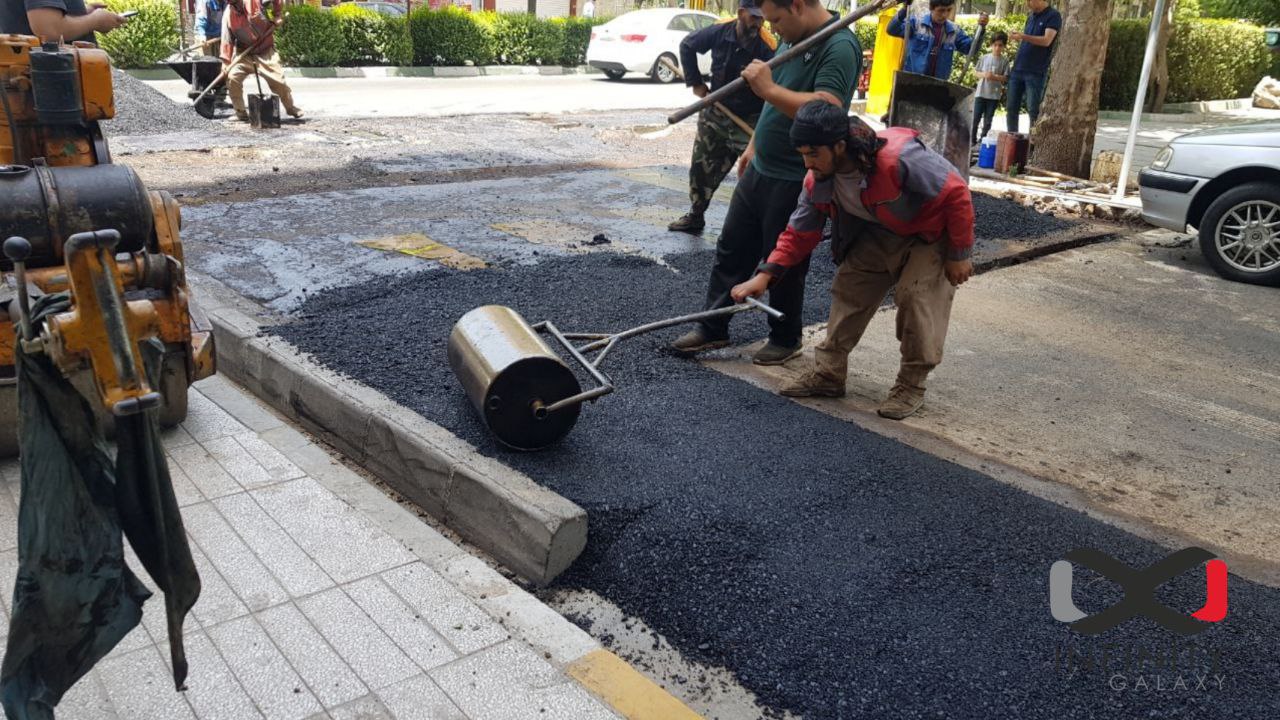Hot Mix Asphalt Paving: Elevating Commercial Parking Lot Specifications
Wiki Article
Opening the Keys of Hot Mix Asphalt Innovation
Exploring the midsts of hot mix asphalt innovation reveals a world where meticulous procedures and specific formulas merge to form our roads and facilities. The blend of fillers, aggregates, and binders isn't merely a building and construction task yet a calculated orchestration of sturdiness and efficiency.Relevance of Hot Mix Asphalt
Warm Mix Asphalt plays a vital role in modern-day framework development as a result of its sturdiness and cost-effectiveness. As the most commonly utilized paving material for roadways, highways, and car park, Warm Mix Asphalt uses an array of advantages that add to its value in building and construction jobs. One vital benefit is its ability to hold up against rush hour lots and extreme climate condition, giving a long-lasting and reliable surface for transport networks. In Addition, Warm Mix Asphalt is cost-efficient in both preliminary building and construction and long-term maintenance, making it a favored selection for many infrastructure jobs.The longevity of Hot Mix Asphalt stems from its composition, which consists of aggregates, binder, and filler products that are very carefully selected and blended to satisfy specific efficiency requirements. Generally, the relevance of Warm Mix Asphalt in facilities advancement can not be downplayed, as it continues to be a cornerstone of modern building practices.
Parts of Asphalt Mixes
The make-up of asphalt mixes includes very carefully chosen accumulations, binder, and filler materials that are essential for achieving details performance requirements. Accumulations are the primary element of asphalt blends, giving toughness and stability. These aggregates can be natural, such as crushed rock or crushed rock, or synthetic, like recycled products from old pavements. The binder, commonly asphalt or asphalt concrete, holds the aggregates with each other and offers adaptability and durability to the mix. The selection of the binder is vital as it straight influences the mix's performance in different weather. Fillers, such as hydrated lime or Rose city cement, are made use of to boost the mix's workability and aging resistance. Angled Parking.The mix and proportion of these parts play a significant function in figuring out the high quality and efficiency of the asphalt mix. Engineers meticulously design the mix to fulfill particular needs, taking into consideration variables like web traffic quantity, environment problems, and sidewalk life expectancy. Appropriate option and balancing of accumulations, binder, and fillers are crucial for producing resilient, lasting asphalt sidewalks.
Combining and Manufacturing Methods

When the wikipedia reference accumulations are selected, the binder, frequently asphalt concrete, is included in bind the materials together. The binder's quality and amount considerably affect the mix's versatility, resistance, and stamina to ecological variables. In addition, fillers like hydrated have a peek at this site lime or Portland cement may be integrated to improve details qualities of the asphalt mix, such as its workability or wetness resistance.
Throughout manufacturing, the accumulations and binder are heated up, usually in between 250-325 ° F(121-163 ° C ), to promote mixing and make certain proper finishing of the accumulations. The blending procedure needs to be detailed to achieve an uniform mix that advertises the desired performance features of the asphalt. Different techniques, such as set mixing or drum blending, are used to achieve regular and high-grade asphalt mixes for building jobs.
Factors Impacting Asphalt Performance
Aspects affecting asphalt performance include an array of variables that impact the durability, long life, and overall quality of asphalt pavements. One crucial factor is the top quality of materials made use of in the asphalt mix.
Ecological problems additionally influence asphalt efficiency. Temperature level variants, dampness seepage, and website traffic tons can all affect the architectural honesty of the sidewalk. Design factors to consider, such as sidewalk density and drainage, are crucial in guaranteeing the lasting efficiency of the asphalt pavement. By thoroughly taking into consideration these aspects, contractors and designers can optimize asphalt performance and boost the life span of sidewalks.
Sustainable Practices in Asphalt Technology
WMA allows for the manufacturing and positioning of asphalt mixes at reduced temperatures contrasted to traditional hot-mix asphalt, resulting in minimized power consumption and greenhouse gas exhausts. The use of porous asphalt blends can aid reduce stormwater drainage issues by enabling water to penetrate via the pavement and into the ground, advertising natural water filtering and reenergize procedures.
Conclusion
To conclude, hot mix asphalt innovation plays a critical role in modern facilities development due to its longevity and cost-effectiveness. By carefully balancing elements, utilizing appropriate mixing methods, and thinking about different elements, engineers can create premium asphalt mixes that withstand rush hour loads and harsh climate condition. Welcoming sustainable methods, such as using recycled materials and warm-mix technologies, additionally improves the environmental friendliness of asphalt technology.
Blending and production techniques in warm mix asphalt innovation involve the precise mix and processing of aggregates, binder, and fillers to develop a sturdy and high-performance asphalt mix.Aspects influencing asphalt efficiency include a range of variables that influence the toughness, durability, and overall top quality of asphalt pavements. Lasting methods in asphalt technology incorporate various campaigns intended at minimizing the environmental effect of asphalt production and paving procedures. By including recovered asphalt sidewalk (RAP) and recycled asphalt tiles (RAS) right into new asphalt blends, the market can considerably reduce the usage of raw products and power, while also lowering landfill waste.
WMA allows for the manufacturing and positioning of asphalt blends at reduced temperature levels contrasted to typical hot-mix asphalt, resulting in decreased power consumption and greenhouse gas discharges.
Report this wiki page